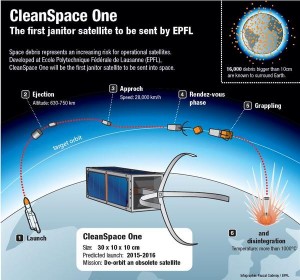A Solution to Space Junk?
The first man-made object to reach space occurred on October 3rd, 1942 by German scientists during WWII. In the seventy years since, thousands of objects have reached orbit including designated phone and television satellites, weather monitors, and of course astronauts. Many objects served their purpose, but many others malfunctioned or became unresponsive and were left to forever circle the Earth.
Objects currently orbiting the Earth include abandoned satellites, used rockets, fragments of spacecraft, and random debris from past collisions. There are now over 500,000 pieces of space junk zipping around the Earth at over 17,500 miles per hour.
Active satellites are on constant alert; the International Space Station, for example, is constantly having to adjust it’s path to avoid dangerous scraps. You may have also seen a U.S. Army commercial where a young member is forced to adjust a military satellite from a stray piece of scrap. NASA is currently able to track debris bigger than 10 cm, but that’s only about 16,000 total pieces, what are we to do about the others?
It has long been feared that this space junk could have a catastrophic impact on our established way of living. Not only can expensive equipment become damaged, any type of future collision will also create thousands of pieces of even more space debris! In fact, in February 2009, an abandoned Russian satellite collided with an active $55 million U.S. satellite; resulting in its complete destruction. Active satellites in orbit today have been insured against damages for over $20 billion!
Scientists at the Swiss Space Center EPFL in Lausanne, Switzerland have unveiled plans for a revolutionary ‘janitor satellite’ being dubbed CleanSpace One, to clean up the mess.
CleanSpace One will use a versatile motor that allows the craft to easily maneuver itself, while matching the same near 18,000 mph speeds of various objects. Once CleanSpace One has reached its safe distance, it would then use a special claw mechanism to reach out and grab a particular piece of junk. Once the task is completed, CleanSpace One would then head back towards the Earth and burn itself up into the atmosphere!
While it sounds like a fantastic idea and cleaning space junk is certainly an area that needs to be addressed soon, each of these Swiss space-maid units are estimated to cost about $11 million dollars. This brings up several questions regarding the efficiency of such a device. How many pieces of debris can one retrieve? What is the environmental impact of having numerous giant metal heaps burning up into the atmosphere? And who would foot the bill?
If the Swiss were able to mass produce these space sweeping devices, as is seemingly their intention, I could see them splitting the tab amongst the nine countries that have proven to be able to send objects into orbit. As with most major projects, there are still questions to be answered, but this is a fascinating development in what had been a worrisome problem facing the world at large.
Check out the video explanation below of CleanSpace One. What are your thoughts on the idea? Can you think of any improvements? Do you think this is a feasible idea? Let us know by commenting below.
Comments
Tags: CleanSpace One, EPFL, International Space Station, space debris, space junk
Trackback from your site.



Comments (3)
Mike
| #
removespacedebris.com and spacedebrisremoval.com available
Reply
Maven
| #
It sounds like there is a limit on the amount of space debris that can be collected hence the need for the satellite to head back to earth and burn up. This points to the need to modify this craft so that it can dispose of its catch internally and then continue collecting new debris. Maybe an incinerator feature? If this could be incorporated, the cost would certainly be worth it to protect our planet from a space garbage assault. The satellite could also be programmed to reenter the atmospher and burn up after a set period of time for example just prior to the end of its anticipated life span.
Reply
International Space Station Narrowly Escapes Disaster | ASTOUNDE.com
| #
[...] are currently designing a project called Clean Space One to help alleviate this problem. The article is a fascinating read if you hadn’t heard of it yet. Hopefully the hard working scientists can [...]
Reply